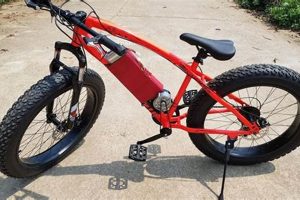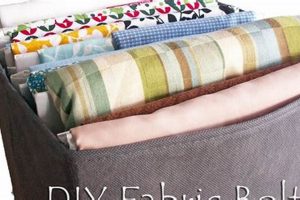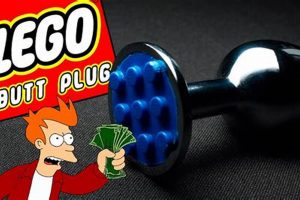Constructing a personalized enclosure for a desktop system offers granular control over aesthetics, functionality, and thermal management. This process often involves selecting raw materials, designing layouts, and employing fabrication techniques to realize a unique housing solution for internal components.
The advantages of creating a custom housing unit include optimized airflow for enhanced cooling, tailored dimensions to accommodate specific hardware configurations, and the opportunity to express individual creativity. Historically, this approach was driven by necessity when commercial options were limited or prohibitively expensive; today, it is often pursued for performance or aesthetic reasons.
Subsequent sections will delve into material selection, design considerations, fabrication methods, and relevant safety precautions associated with building a customized enclosure for a computer system.
Considerations for Custom Computer Enclosure Fabrication
The creation of a bespoke computer housing necessitates careful planning and execution. The following points outline crucial aspects to consider during the design and construction phase.
Tip 1: Material Selection: Choose materials based on thermal conductivity, structural integrity, and aesthetic properties. Aluminum offers excellent heat dissipation, while acrylic provides transparency for showcasing internal components. Evaluate the pros and cons of each material in relation to project requirements.
Tip 2: Precise Measurement and Planning: Accurately measure all components to ensure proper fit within the enclosure. Create detailed blueprints or CAD models to visualize the design and identify potential conflicts before commencing fabrication.
Tip 3: Thermal Management Strategy: Plan for effective airflow to prevent overheating. Consider the placement of fans, heatsinks, and liquid cooling systems. Conduct thermal simulations, if possible, to optimize cooling performance.
Tip 4: Cable Management Solutions: Design integrated cable routing solutions to maintain a clean and organized interior. This promotes better airflow and simplifies future maintenance. Implement grommets and tie-down points to secure cables effectively.
Tip 5: Structural Integrity: Ensure the enclosure is structurally sound to support the weight of internal components. Reinforce critical areas with bracing or thicker materials to prevent warping or collapse.
Tip 6: Accessibility and Serviceability: Design the enclosure to allow for easy access to components for future upgrades or repairs. Removable panels and strategically placed access points are crucial for maintainability.
Tip 7: Safety Precautions: Adhere to all relevant safety guidelines when working with power tools and electrical components. Ground the enclosure properly to prevent electrical shocks. Use appropriate personal protective equipment, such as safety glasses and gloves.
Attention to these details significantly improves the functionality, aesthetics, and longevity of a custom-built computer housing. A well-planned and executed project results in a unique and efficient system.
The subsequent sections will explore specific techniques and tools used in the fabrication of custom computer enclosures.
1. Material Properties
The selection of appropriate materials directly impacts the performance and durability of a custom-built computer enclosure. Thermal conductivity, structural strength, and electromagnetic interference (EMI) shielding capabilities are critical material properties that must be considered during the design phase. The choice of material directly influences the internal operating temperatures, the enclosure’s ability to withstand physical stress, and the potential for interference with sensitive electronic components.
For example, aluminum, due to its high thermal conductivity, is frequently employed in constructing enclosures intended for high-performance systems. Its ability to dissipate heat efficiently prevents thermal throttling and enhances component lifespan. Conversely, acrylic, while visually appealing due to its transparency, possesses lower thermal conductivity and reduced structural strength, making it more suitable for systems with lower thermal output and requiring primarily aesthetic considerations. A practical example involves comparing two identical systems, one housed in an aluminum enclosure and the other in an acrylic enclosure, under sustained load. The system within the aluminum enclosure demonstrably exhibits lower operating temperatures.
In conclusion, understanding material properties is paramount in designing and fabricating a custom computer enclosure. The selected material dictates the enclosure’s structural integrity, thermal performance, and its ability to mitigate electromagnetic interference. Inadequate consideration of these factors can lead to compromised system performance, reduced component lifespan, and potential system instability. Careful material selection therefore represents a foundational element in the success of any bespoke computer enclosure project.
2. Dimensional Accuracy
Dimensional accuracy is paramount in the realm of creating a customized computer enclosure. The precision with which measurements are taken and translated into the physical structure directly impacts the fit and functionality of internal components.
- Component Compatibility
Accurate dimensions are essential to ensure compatibility with motherboards, power supplies, graphics cards, and storage devices. Variations from specified dimensions can lead to misalignment, interference, and ultimately, the inability to install these critical components. An example is failing to account for the I/O shield height, resulting in the inability to properly mount the motherboard to the back panel.
- Thermal Management Effectiveness
Precise dimensions contribute to effective thermal management. Ill-fitting components can obstruct airflow, causing localized hotspots and reduced cooling efficiency. For instance, improper spacing between fans and heatsinks or between components prevents optimal dissipation of heat. Moreover, inaccurately sized vents will inhibit the cooling performance of the enclosure.
- Structural Integrity
Accurate dimensions are critical for the structural integrity of the enclosure. Deviations from planned measurements can weaken the frame, leading to instability and potential damage to internal components. For example, an enclosure with misaligned panels or supports can flex under the weight of the components, causing stress on connectors and circuit boards.
- Aesthetic Consistency
Beyond functionality, dimensional accuracy contributes to the overall aesthetic appeal of the enclosure. Precise cuts and align
ment of panels result in a professional and visually pleasing finish. Inconsistencies in dimensions are immediately apparent and detract from the overall quality of the project. Furthermore, the precision of the enclosure is an important factor in the final product.
The preceding points illustrate the critical relationship between dimensional accuracy and the successful construction of a customized computer enclosure. A lack of precision in measurement and execution can compromise component compatibility, thermal management, structural integrity, and aesthetic consistency, thereby diminishing the overall value and performance of the finished product. Proper execution ensures the stability of the build.
3. Thermal Efficiency
In the realm of custom computer enclosure construction, thermal efficiency assumes paramount importance. Effective heat dissipation is critical for maintaining optimal performance and extending the lifespan of internal components. Bespoke designs offer opportunities to tailor thermal management solutions precisely to the system’s requirements.
- Airflow Optimization
Custom enclosures allow for strategic placement of intake and exhaust fans to create optimal airflow paths. This can involve designing ducting to direct cool air to specific components, such as the CPU or GPU, and ensuring efficient removal of hot air. An example is the creation of a dedicated air channel for the GPU, preventing heat buildup near the motherboard.
- Material Selection for Heat Dissipation
The choice of materials significantly impacts thermal performance. Aluminum, known for its high thermal conductivity, is often utilized for heat sinks and enclosure panels to facilitate heat transfer. Copper, while more expensive, offers even greater thermal conductivity. Selecting appropriate materials is critical for drawing heat away from sensitive components. An illustrative case is comparing an aluminum case against an acrylic case in a high workload environment. The aluminum enclosure shows lower internal temperatures.
- Liquid Cooling Integration
Bespoke enclosures provide the flexibility to integrate liquid cooling systems effectively. Custom loop configurations can be designed to target specific components, offering superior cooling performance compared to air cooling alone. This often involves creating mounting points for radiators, pumps, and reservoirs. A practical example is incorporating custom water blocks for the CPU and GPU that efficiently conduct heat into a coolant loop.
- Passive Cooling Solutions
Beyond active cooling methods, custom enclosures can incorporate passive cooling elements, such as large heat sinks and strategically placed vents, to facilitate natural convection. This reduces reliance on fans, minimizing noise levels and energy consumption. Utilizing a large aluminum heatsink to passively cool the system’s VRMs and power delivery can significantly improve the system’s operating temperatures during prolonged operation.
These facets highlight the pivotal role of thermal efficiency in “case computer diy”. A well-designed enclosure prioritizes airflow, leverages appropriate materials, and integrates advanced cooling solutions to ensure stable and reliable system operation. Careful consideration of these elements results in a high-performing and long-lasting computing platform.
4. Structural Stability
In the context of bespoke computer enclosure construction, structural stability represents a critical engineering consideration. It directly influences the long-term reliability and operational safety of the entire system. The enclosure must withstand the cumulative weight of internal components, resist vibrations, and maintain its integrity during transport or relocation. Failure to adequately address structural concerns can lead to component damage, system instability, or even catastrophic failure. For example, an enclosure constructed from inadequately reinforced acrylic may buckle under the weight of a large graphics card, leading to deformation or cracking. Similarly, a frame lacking sufficient rigidity could amplify vibrations from fans or hard drives, resulting in increased noise and potential component damage. The design should account for these factors, ensuring the enclosure maintains its shape and protects the delicate electronic components within.
Achieving adequate structural stability involves careful material selection, thoughtful design, and precise fabrication techniques. Materials must be chosen based on their strength-to-weight ratio, resistance to deformation, and suitability for the intended application. The design should incorporate reinforcing elements, such as ribs, gussets, or strategically placed supports, to distribute loads evenly and prevent localized stress concentrations. Fabrication techniques, such as welding, riveting, or bonding, must be employed to create robust and durable joints. A practical example of this is the use of a reinforced steel frame within an aluminum enclosure to provide enhanced rigidity and support for heavy components. Another example is the use of properly sized and spaced rivets to secure panels together, preventing loosening or separation over time.
In summary, structural stability is not merely an aesthetic consideration but a fundamental engineering requirement for custom computer enclosures. Insufficient structural integrity can compromise system reliability, lead to component damage, and pose safety hazards. By prioritizing material selection, design optimization, and precise fabrication, the structural integrity of custom computer enclosures can be ensured, thus contributing to the longevity and stability of the contained computer system. The practical significance of this understanding manifests in the system’s resilience, its ability to withstand everyday stresses, and the peace of mind it provides to the builder and user.
5. Cable Management
Effective cable management within a custom computer enclosure is critical for optimizing airflow, maintaining system aesthetics, and simplifying future component maintenance. The design and implementation of cable routing solutions directly impact the overall functionality and usability of the finished system. A meticulously organized interior contributes to improved thermal performance and reduced downtime during upgrades or repairs.
- Airflow Optimization
Unmanaged cables obstruct airflow, creating pockets of stagnant air that contribute to increased component temperatures. Strategic cable routing minimizes these obstructions, allowing for more efficient heat dissipation. Implementing cable tie-down points and routing channels ensures clear airflow paths, reducing the risk of overheating and performance degradation. An example is the placement of cables behind the motherboard tray to ensure the CPU cooler receives adequate airflow.
- Component Accessibility
Well-managed cables facilitate easier access to components during upgrades, troubleshooting, or repairs. Bundling and securing cables prevents them from interfering with the removal or installation of hardware. Clear cab
le pathways also reduce the risk of accidental disconnections or damage to sensitive connectors. Consider a scenario where a GPU needs to be replaced; neatly routed cables minimize the disruption to other components during the removal process. - System Aesthetics
Neatly routed and hidden cables contribute significantly to the overall aesthetic appeal of the custom-built computer. A clean and organized interior enhances the visual impact of the system, showcasing the internal components in an appealing manner. Implementing cable sleeves or custom-length cables further enhances the aesthetic outcome. A well-executed cable management strategy transforms the interior from a cluttered mess to a visually appealing showcase.
- Reduced Electrical Interference
Proper cable management can minimize electrical interference between cables, improving signal integrity and system stability. Separating power cables from data cables and implementing shielded cables reduces the risk of signal degradation or data corruption. This is particularly important for sensitive components, such as audio cards or storage devices. Strategically arranging cables prevents unwanted signal noise from disrupting performance.
The preceding points demonstrate the integral relationship between cable management and “case computer diy”. A well-executed cable management strategy not only enhances the system’s aesthetics but also improves its thermal performance, simplifies maintenance, and reduces the risk of electrical interference. The application of considered cable management techniques is a hallmark of a professionally built and well-maintained custom computer enclosure.
6. Component Accessibility
Component accessibility is a critical factor in the design and execution of any custom-built computer enclosure. The ease with which internal components can be accessed for maintenance, upgrades, or troubleshooting directly impacts the long-term usability and value of the system. A well-designed enclosure prioritizes component accessibility, minimizing the time and effort required for servicing and ensuring the system remains adaptable to future hardware modifications. The cause-and-effect relationship is clear: limited accessibility results in increased repair times, heightened frustration during upgrades, and a greater risk of accidental damage to other components during servicing. As a core tenet of practical design, the principle of component accessibility is often overlooked. For instance, poorly placed support structures or excessively complex cable routing can severely hinder access to critical components like the CPU, RAM, or storage devices. A system requiring complete disassembly to replace a failed fan exemplifies a design flaw related to accessibility.
Several design strategies enhance component accessibility within a custom enclosure. Modular construction, utilizing removable panels and tool-less retention mechanisms, facilitates quick and easy access to internal components. Strategic placement of access ports and cable management solutions further streamlines the process. The selection of appropriate hardware, such as modular power supplies with detachable cables, also contributes to improved accessibility. A practical example is the design of a removable motherboard tray, which allows the entire motherboard assembly to be easily extracted for servicing or modification without disturbing other components. Also, using standardized screw types and sizes and ensuring easy availability from hardware stores is a practical approach to improving access to repair and replacement operations. Another approach is to use quick-release mechanisms for front panel connections and fan mounts.
In summary, component accessibility is an essential consideration in custom computer enclosure construction. It directly impacts the maintainability, upgradeability, and overall longevity of the system. By prioritizing modular design, strategic component placement, and thoughtful cable management, a custom enclosure can be optimized for ease of use and adaptability, ensuring the system remains a valuable and functional asset for years to come. Ignoring component accessibility poses substantial risks, leading to increased costs, frustration, and potentially compromised system performance.
Frequently Asked Questions About Custom Computer Enclosures
The following addresses common inquiries regarding the design and construction of bespoke computer housings.
Question 1: What is the primary benefit of constructing a customized computer enclosure compared to utilizing a commercially available case?
Creating a custom enclosure offers unparalleled control over the system’s thermal management, component compatibility, and aesthetic design. A commercially available enclosure often presents compromises that a custom build can eliminate.
Question 2: Which materials are most suitable for constructing a durable and thermally efficient computer enclosure?
Aluminum, steel, and certain high-density plastics are frequently employed. Aluminum provides excellent thermal conductivity and a good strength-to-weight ratio. Steel offers robust structural integrity, while plastics can be used for non-structural elements.
Question 3: What are the essential tools required for fabricating a custom computer enclosure?
A comprehensive toolkit includes measuring instruments, cutting tools (such as saws and shears), drilling equipment, fastening tools (riveters, screwdrivers), and safety equipment (eye protection, gloves).
Question 4: How should airflow be optimized within a custom computer enclosure?
Strategic placement of intake and exhaust fans is critical. The design should facilitate a clear path for cool air to enter the enclosure, flow over heat-generating components, and exit efficiently.
Question 5: What precautions should be taken to prevent electrical hazards during the assembly process?
All electrical components must be properly grounded. Avoid working with live circuits, and ensure all connections are secure and insulated. A power supply with appropriate safety certifications is recommended.
Question 6: How can component compatibility be ensured before commencing the fabrication process?
Accurate measurements of all internal components are essential. Creating detailed blueprints or CAD models can help visualize the design and identify potential conflicts before construction begins.
The understanding of the material properties, tools, and overall structure mentioned in questions ensures the longevity of the build.
The subsequent sections will cover the important maintenance and care procedures for the continued reliability of the custom-built computer.
Concluding Remarks on Custom Computer Enclosure Construction
This exploration has addressed the core tenets of designing and fabricating bespoke computer housings. Material selection, dimensional accuracy, thermal efficiency, structural stability, cable management, and component accessibility have been identified as critical considerations. Neglecting any of these aspects can compromise the performance, reliability, and longevity of the completed system. Adherence to established engineering principles and meticulous execution are essential for achieving a successful outcome.
The pursuit of custom enclosure construction demands a commitment to precision and a thorough understanding of the underlying principles. The successful appli
cation of these principles yields a highly optimized and aesthetically refined computing platform, tailored to specific individual needs. Continued innovation in materials and fabrication techniques promises further advancements in the field, enabling even greater levels of customization and performance. The creation of custom computer enclosures represents a continuous evolution, driven by the pursuit of optimal computing solutions.


![Easy DIY Burger Press for Pan [Guide + Tips] The DIY Hub: Creative Crafts, Repairs & Life Hacks Easy DIY Burger Press for Pan [Guide + Tips] | The DIY Hub: Creative Crafts, Repairs & Life Hacks](https://craftingdiycenter.com/wp-content/uploads/2025/07/th-5743-300x200.jpg)




